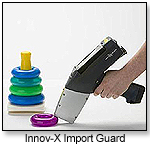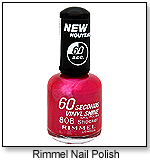 |

Tools:








One Year Later: Beyond China, Beyond LeadPhthalates and Other Chemicals Fall Under National Scrutiny
| “I think customers have come to expect us to research the toys, and take care of them — that’s our job.” — Kate Tanner, Kidstop |
Despite an onslaught of scientific reports, enacted legislation and consumer calls-to-action since the 2007 toy recalls for lead hazards and defective designs, hard statistical data on the effect and risks of phthalates is still being gathered and assessed, and there may be other chemicals of concern.
 Last year’s recalls increased consumer awareness and concern about health risks associated with kids’ toys. Concurrently, California passed AB1108 — also known as the California Toxic Toys Bill — in October, making the state the first to ban the use of phthalates in children’s toys. Last year’s recalls increased consumer awareness and concern about health risks associated with kids’ toys. Concurrently, California passed AB1108 — also known as the California Toxic Toys Bill — in October, making the state the first to ban the use of phthalates in children’s toys.
In February 2008, Toys “R” Us and Wal-Mart announced stricter guidelines regarding levels of lead, phthalates and other elements in toys and infant products. In August, Congress established, and the President signed, the Consumer Product Safety Improvement Act, lowering the amounts of lead and phthalates that are acceptable in toys.
HOW DANGEROUS ARE PHTHALATES?
 Phthalates are oil-like chemicals used to make plastics softer and more flexible. Toys are just one of many products that can contain them. According to a 2000 National Institute of Environmental Health Sciences review, detergents, cosmetics (such as nail polish) and wood finishes are sources of human exposure to phthalates. Phthalates are oil-like chemicals used to make plastics softer and more flexible. Toys are just one of many products that can contain them. According to a 2000 National Institute of Environmental Health Sciences review, detergents, cosmetics (such as nail polish) and wood finishes are sources of human exposure to phthalates.
The most common exposure used to be through food that had come into contact with plastic packaging containing the phthalate DEHP; however, an NIEHS report notes that the phthalate has since been removed from consumer products. Furthermore, another report explains that DINP (diisononyl phthalate), which is commonly used in toys, is used sparingly in food packaging.
Children may be exposed to higher levels of DINP (up to 10–100 fold higher) than adults because infants and small children mouth toys and other articles that contain DINP that can migrate into saliva and be swallowed. DINP is not used in medical devices; therefore intravenous exposure does not occur.
|
VARIOUS CHEMICALS MAY POSE RISKS
The Ecology Center in Michigan has established HealthyToys.org, which conducts and reports ongoing tests of children’s products. Using Innov-X Systems’ X-Ray Fluorescent Import Guard, they test for lead as well as mercury, chromium, bromine, arsenic and cadmium.
“Less than 5 percent of toys tested contain lead. But nearly a third contained PVCs, which are more likely to have chemical additives that are associated with different health concerns,” said Research Director Jeff Gearhart.
“Oftentimes, the presence of PVC indicates the need for further testing,” explained Andrea Klos, business development specialist at Innov-X, noting that the Import Guard doesn’t test for phthalates but does detect PVC.
Frank W. Clarke, consultant to the Toy Industry Association, told TDmonthly that “all of these substances are covered by the Federal Hazardous Substances Act (FHSA), and their regulation in consumer products is under the jurisdiction of the CPSC. The TIA certainly would not want children to be exposed to any dangerous level of these chemicals. We believe there is little, if any, available incidence of these chemicals in toys and that parents should not be concerned about them.” |
According to a 2006 report by non-profit STATS, updated in March 2008, the controversy around phthalates originated from a research study in which pregnant lab rats exposed to very high levels produced male offspring with genital deformities and fertility problems. Environmental Health Perspectives then published a subsequent study on pregnant women and male offspring that found that certain phthalates appeared to correspond to a shorter anogenital index, although the study did not examine the issue of genital defects as none of the children exhibited any.
In 2003, a petition made by Public Interest Research Group to the Consumer Product Safety Commission to ban DINP was rejected because there was no demonstrable risk that DINP migrated from vinyl toys in the way that children “mouth” toys.
Chris Bryant, managing director of the Chemical Products & Technology Division at the American Chemistry Council, told TDmonthly Magazine that parents do not need to be concerned about phthalates in toys. “DINP ... has been extensively reviewed and deemed to be safe for use in toys by the CPSC and the EU. … Phthalates that have been permanently restricted are not generally found in children’s products.”
STATS noted that based on research, “legislation restricting the use of phthalates in toys is going to have virtually no effect on phthalate exposure.”
MOVING TO PROTECT CHILDREN
Yet, Nsedu Obot Witherspoon, executive director of The Children’s Environmental Health Network (CEHN), told TDmonthly, “We need to start by protecting the most vulnerable populations, the fetus and the young child. The problem is that children are not exposed to one phthalate at a time; they are exposed in mixtures.”
Among the CEHN’s recommendations are that children not mouth toys and other objects that are high in phthalates, and that women of childbearing age consider products they are using.
Dr. Mary Wolff of the Mount Sinai School of Medicine, in her publication “Inner City Toxicants, Child Growth and Development,” noted that “two classes of industrial chemicals with endocrine-disrupting capability — the phthalates and the alkylphenols — have become widely dispersed in the urban built environment, and significant levels of phthalates are now nearly ubiquitous in the bodies of Americans. Infants and children appear especially susceptible to disruptors, because of their disproportionately heavy exposures and the vulnerability of their still-forming organs.”
An October 2007 study prepared by Exponent for the Toy Industry Association focused on the particular phthalate DINP. Researchers found that “current exposure of children to DINP-containing toys would pose a minimal to nonexistent risk of health effects” and that there’s a lack of scientific evidence to contend that DINP causes developmental and reproductive problems at low doses.
|
PARENTAL CONCERN DECLINES
At the height of the 2007 toy recalls, Kathy Jenkins of Toys in the Attic in Dalton, Ga., arranged to have a testing company come to her store for an entire day, and invited people to bring their toys to be tested for lead at no charge. Despite heavy coverage by TV, radio and print, only 16 people showed up.
“Consumer response was pathetic. We were expecting it to be very busy. It was like they (parents) were worried, but not actually enough to make the effort.”
David Campbell, owner of Amazing Toys in Great Falls, Mont., said he’s not heard any concern from customers about phthalates or other chemicals since last year’s lead scare. “There’s still a certain amount of concern by grandparents about toys made in China, although not from parents. I assure them that everyone has gone back and retested toys (for lead), and that toys are safe in that regard.”
Conversely, Jeremy Weir of Exposing Lead, based in Roswell, Ga., felt that awareness is “definitely up.” He uses the Import Guard to conduct in-home and daycare-center tests.
“Families with special needs kids are the ones that are really taking action about it, and their awareness was high before the toy recalls. Many special needs kids, especially those who are autistic, don’t rid themselves of heavy metals the way our bodies do, and they are constantly going through chelation therapy [to remove the metals],” he said. |
REMOVING CHEMICALS, GAINING TRUST
While lead and phthalates have made headlines, some organizations believe that other chemicals that may be present in toys are cause for concern. [see Sidebar 1] New federal regulations should help mitigate conflicting regulations across states, although some states may choose to establish further testing protocols.
David Campbell, owner of Amazing Toys in Great Falls, Mont., pointed out that some manufacturers are already making toys without phthalates. “There’s no reason to use phthalates, except that it makes manufacturing cheaper, and that’s not a good reason,” he told TDmonthly.
Although many parents haven’t shown as much concern as one might expect [see Sidebar 2], Kate Tanner, owner of Kidstop in Scottsdale, Ariz., shared that since the 2007 recalls, toy retailers have had to work hard to gain customers’ trust.
 “I think customers have come to expect us to research the toys, and take care of them — that’s our job. We have a binder of letters from manufacturers, educating our customers on what labels to look for and testing being done. … It is children’s safety we are after, and not the bottom line.” “I think customers have come to expect us to research the toys, and take care of them — that’s our job. We have a binder of letters from manufacturers, educating our customers on what labels to look for and testing being done. … It is children’s safety we are after, and not the bottom line.”
See TDmonthly’s previous coverage of these and similar issues in PVC Toy Scare: Manufacturing Danger and Plastic Death: Truth, or Scare?
 Writer's Bio: Writer's Bio: Claudia Newcorn has been a freelance writer and editor for over 10 years, after having spent more than a decade in marketing and product management. She writes for both businesses and individual clients, crafting copy, content and advertising. Her articles appear in newspapers, magazines and specialty publications nationwide (www.acornmarketing.com). She is also the author of an award-winning fantasy fiction book, "Crossover," and several published short stories (www.claudianewcorn.com). Read more articles by this author
THIS BANNER IS AN AD:

• • • • • • • • • • • • • • • • • | • • • • • • • • • • • • • • • • |
Back to TDmonthly's front page
|  |
Advertise on TDmonthly

|

